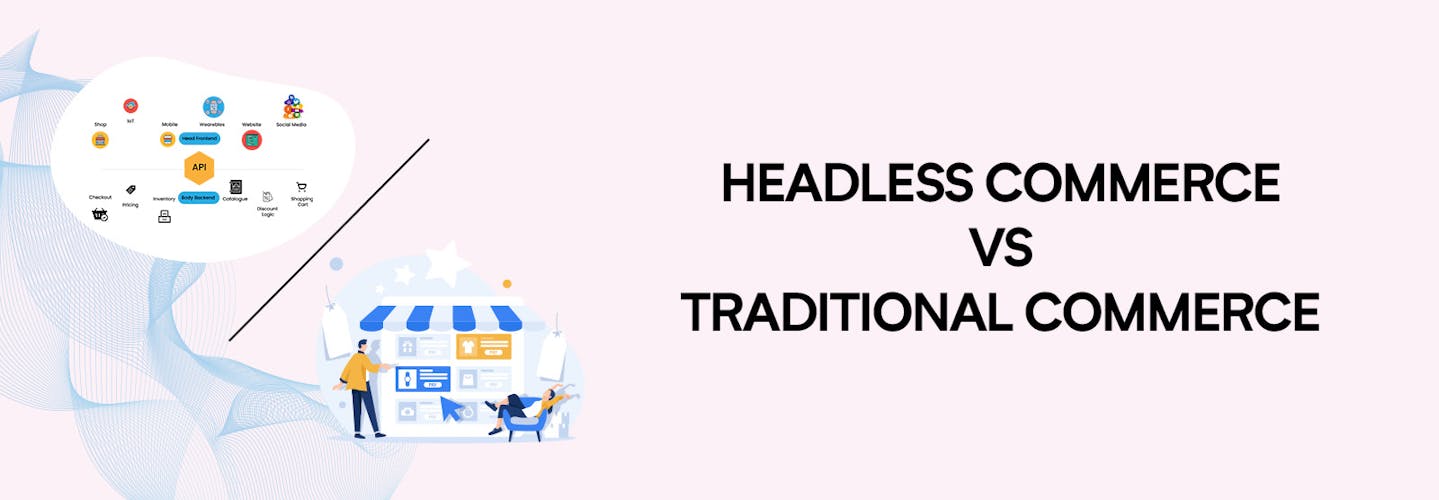
Headless Commerce vs Traditional Commerce: Which One Is Better for Your Business?
As eCommerce continues to grow, businesses are constantly looking for ways to improve their online shopping experience.
ECommerce has been growing rapidly over the past few years, especially during the pandemic when people preferred online shopping.
This trend is expected to continue, and by 2023, the global eCommerce market is projected likely to be higher than $6.3 trillion.
Therefore, it is crucial for businesses to keep up with this trend and adapt their eCommerce strategies to provide the best possible online shopping experience.
In the world of eCommerce, two terms that are gaining popularity are Headless Commerce and Traditional eCommerce. They both offer different benefits and drawbacks, and choosing the right one can be a game-changer for your business.
In this article, we will compare headless commerce and traditional commerce to help you decide which one is better for your business.
What is Headless Commerce?
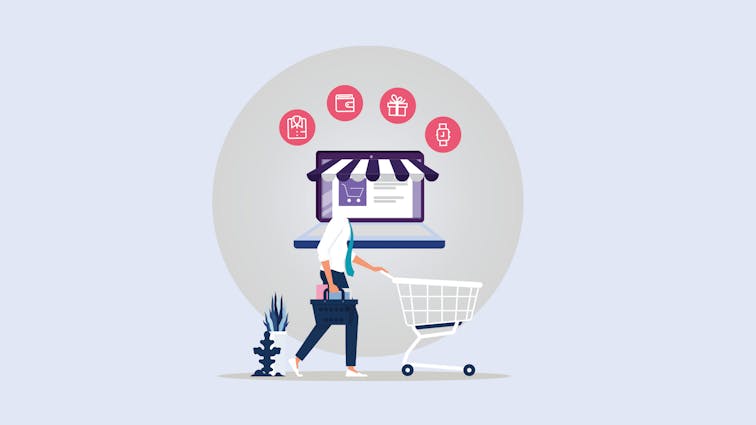
Headless Commerce separates the front-end user interface (UI) and design from the back-end data and logic, essentially “decapitating” the head of a traditional eCommerce platform.
This relatively new approach in online commerce focuses on APIs and allows businesses to create fully customized and developer-driven experiences.
Pros of Headless Commerce
- Flexibility: With Headless, developers can create any front-end design they like without being limited by the eCommerce platform’s built-in templates.
- Faster Loading Times: By being decoupled from the back-end, the front-end can be designed for optimal performance, resulting in faster load times and a better user experience.
- API-driven: Connecting other applications and services through APIs is easier than ever, allowing for more seamless integrations. Scalability: Headless Commerce enables businesses to scale and evolve more quickly as it’s more adaptable to change.
- Enhanced Security: The separation between the front-end and back-end systems reduces the likelihood of security breaches, providing fewer vulnerabilities for potential attackers.
- Future-Proofness: As new technologies emerge, Headless Commerce allows businesses to adopt these advancements more easily and stay current.
Cons of Headless Commerce
- Complexity: The separation of front-end and back-end could require more technical expertise and coordination among teams.
- Higher Development Cost: Building and maintaining a custom front-end can be expensive and time-consuming.
- Limited Out-of-the-Box Features: Some features common in Traditional eCommerce platforms might not be available by default in a Headless Commerce solution, requiring additional development and investment.
- Steeper Learning Curve: With its unique approach to eCommerce, team members might require more time and training to become proficient with a Headless Commerce platform.
What is Traditional Commerce?

Traditional eommerce refers to the more established way of building and managing online stores, using a monolithic architecture that houses the front-end and back-end as a single unit.
This approach often relies on pre-built templates and pre-packaged solutions for design and functionality, making it easier to set up and launch an online store.
Pros of Traditional Commerce
- Simplicity: Traditional eCommerce platforms are generally easier to set up, as they offer built-in design templates and features, making it faster to launch an online store.
- Lower Development Cost: Because of their pre-packaged nature and typically less intricate customization options, traditional eCommerce solutions usually involve lower development and maintenance expenses.
- Packed with Features: Traditional platforms often come with a wide array of built-in features and functionality, making it simple for businesses to manage their online stores.
- Shorter Learning Curve: Team members usually find it simpler to familiarize themselves with Traditional eCommerce platforms, as they offer more standardized features and experiences.
- All-in-One Solution: Since both the front-end and back-end are integrated, businesses benefit from a unified, all-in-one platform, easing the management process.
Cons of Traditional Commerce
- Limited Customization: Relying on pre-built templates and features may make it difficult to create a truly unique and tailored experience for your users. Slower
- Loading Times: Traditional eCommerce platforms can suffer from lower performance due to their monolithic architecture, which may affect customer experience and conversions.
- Limited API Integration: Integrating third-party apps and services might be more challenging or time-consuming with traditional eCommerce solutions.
- Inflexibility: Adapting to market changes or scaling might be slower with a traditional eCommerce platform, due to its rigid nature.
- Obsolescence Risk: As technology and consumer demands evolve, Traditional eCommerce platforms may struggle to keep up and may require extensive updates or even migration to a more modern software solution.
Comparing the Key Differences:
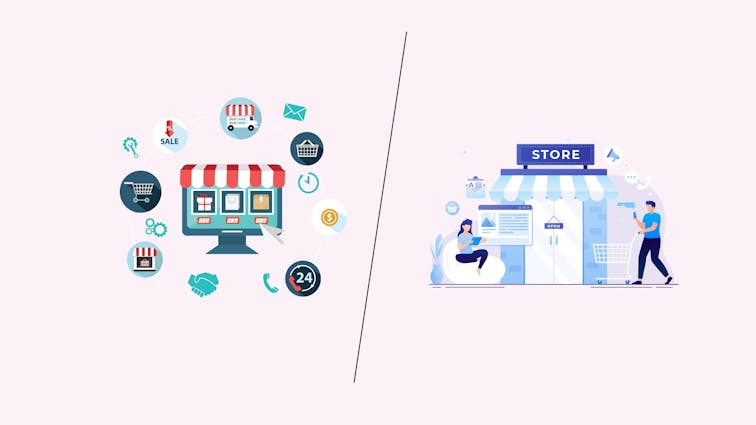
To determine which approach is better for your business, let’s compare the key differences between headless commerce and traditional eCommerce across various aspects.
1. Architecture and Flexibility
In traditional eCommerce, the architecture is tightly coupled, meaning the frontend and backend are interconnected within a single platform.
This limits the flexibility to modify or upgrade individual components without affecting the entire system.
On the other hand, headless commerce offers a decoupled architecture, allowing businesses to select the best-in-class solutions for each aspect.
This flexibility enables customization and empowers businesses to adapt their online stores to evolving customer demands.
2. User Experience and Performance
When it comes to user experience, traditional eCommerce platforms often provide pre-designed templates and themes that can be easily customized.
However, the customization options may be limited, and businesses may struggle to create truly unique and immersive experiences for their customers.
Headless commerce, with its separation of frontend and backend, offers the freedom to build custom user interfaces that align perfectly with the brand’s identity. This can result in enhanced user experiences that are tailored to specific target audiences.
In terms of performance, headless commerce has the advantage of leveraging modern technologies like microservices and API-driven architectures.
These technologies enable faster page load times, better scalability, and improved overall performance. Traditional eCommerce platforms, while generally reliable, may face limitations in handling high traffic volumes or complex integrations.
3. Development and Maintenance
Traditional eCommerce platforms often provide intuitive interfaces and drag-and-drop functionalities, making them more accessible to businesses with limited technical expertise.
These platforms handle most of the development and maintenance tasks, including security updates and hosting. However, customization beyond the available templates may require coding knowledge or the involvement of developers.
Headless commerce, being more developer-centric, requires a higher level of technical expertise. Businesses opting for headless commerce will need skilled developers to build and maintain the frontend and backend separately.
While this may entail more initial effort, it also provides greater control and the ability to fine-tune the system to meet specific business needs.
4. Integrations and Scalability
Both headless commerce and traditional eCommerce platforms offer integrations with various third-party tools and services. However, headless commerce excels in this aspect due to its modular nature.
Businesses can choose specific solutions for each component, whether it’s a CMS, CRM, or marketing automation tool, and seamlessly integrate them into their headless architecture. This allows for a more tailored tech stack and enables businesses to leverage the best tools available.
Scalability is also an important consideration. Headless commerce, with its modular architecture, offers better scalability as businesses can scale each component independently.
If there is a sudden surge in frontend traffic, additional frontend servers can be added without affecting the backend.
This flexibility allows businesses to handle growth and seasonal demands more effectively. Traditional eCommerce platforms, while scalable to a certain extent, may have limitations due to the tightly coupled architecture.
Case Studies: Success Stories of Headless Commerce and Traditional Commerce
Certainly! Here are two real-life examples of businesses that have successfully implemented headless commerce and traditional Commerce:
1. Allbirds - Headless Commerce Success Story:

Allbirds, a popular sustainable footwear brand, implemented headless commerce to provide their customers with a unique and seamless shopping experience.
By decoupling their frontend and backend, they were able to leverage multiple channels such as web, mobile, and in-store touchpoints.
Allbirds created a highly customized and responsive frontend interface that showcased their products in an engaging and interactive manner.
This approach allowed them to deliver consistent brand experiences across different devices, resulting in increased customer satisfaction and conversion rates.
With the flexibility of headless commerce, Allbirds successfully scaled their business and continued to innovate in the competitive footwear industry.
2. Amazon- Traditional Commerce Success Story:
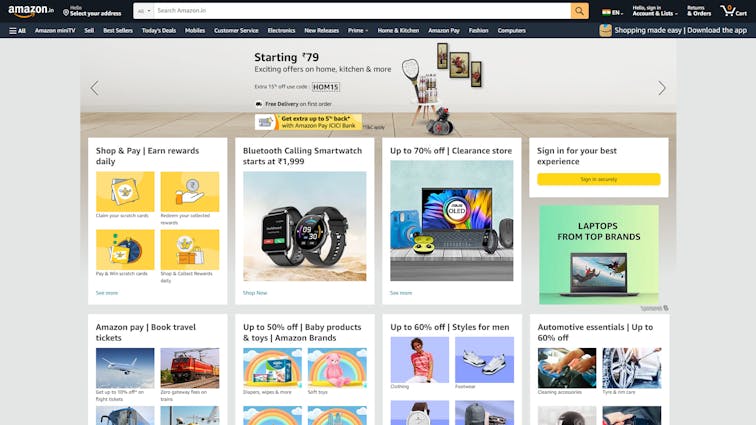
Amazon, one of the world’s largest eCommerce platforms, is a prime example of a successful traditional eCommerce implementation.
With a focus on convenience, Amazon built an intuitive and user-friendly platform that revolutionized online shopping. By providing a seamless browsing and purchasing experience, along with a wide range of products and fast delivery options, Amazon gained the trust and loyalty of millions of customers.
Through continuous optimization of their platform’s performance and customer service, Amazon grew into a global eCommerce giant, expanding its product offerings beyond books to include almost every imaginable category.
The success of Amazon’s traditional eCommerce approach lies in its ability to prioritize customer satisfaction and consistently exceed expectations.
Making the Decision: Headless Commerce vs Traditional Commerce
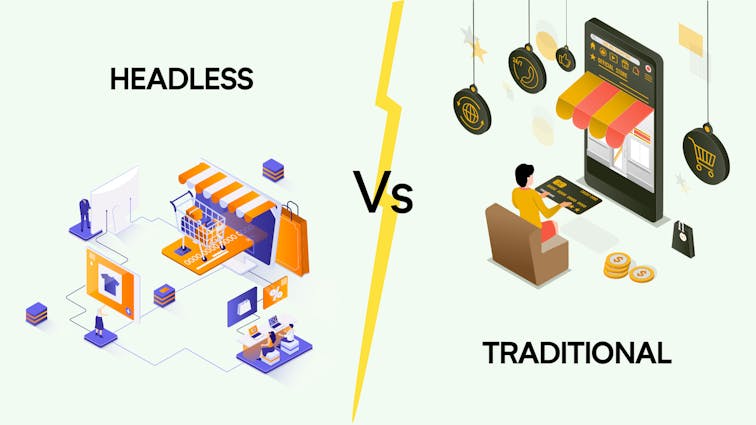
When deciding between Headless Commerce and Traditional eCommerce, consider your business’s unique needs, goals, and resources. Here are some factors to take into account:
1. Technical Expertise
If your team has the technical know-how and resources, Headless Commerce can provide greater flexibility and customization.
However, if you prefer an easier setup and have limited in-house development capabilities, Traditional eCommerce might be more suitable.
2. Budget
Consider the development and maintenance costs associated with each option. Headless Commerce, while providing additional flexibility and performance benefits, can be more expensive to implement and maintain.
Traditional eCommerce platforms can be more cost-effective, especially for smaller businesses.
3. Scalability
If you anticipate frequent changes and scaling requirements for your business, Headless Commerce may have the edge due to its adaptability and ease of integration with other services.
Traditional eCommerce platforms, on the other hand, might be more restrictive and slower to adapt to change.
4. User Experience
Take into account the desired user experience for your customers. Headless Commerce enables greater customization for optimal performance and a unique user experience.
On the other hand, Traditional eCommerce has a more standardized approach, which may limit differentiation but simplifies the process using built-in templates and features.
5. Integration Needs
Assess your business’s requirements for integrating with other applications and services. Headless Commerce utilizes APIs, making it easier and faster to connect with third-party tools.
Traditional eCommerce solutions might be more limited in API integration, which can be a crucial factor if your business relies heavily on external services.
Which One Is Better For Your Business?
The answer to this question depends on the specific needs and goals of your business. Traditional eCommerce platforms are a great option for small businesses that don’t require a high level of customizability or scalability.
They’re also easier to use and require less technical expertise, which means you can focus on other aspects of your business.
However, if you’re looking for a more customized and flexible eCommerce solution, Headless Commerce is the way to go.
While it requires more technical expertise and may take longer to set up, it offers complete control over your storefront and backend, allowing you to create a unique shopping experience for your customers.
Ready To Go Headless With Aasaan?
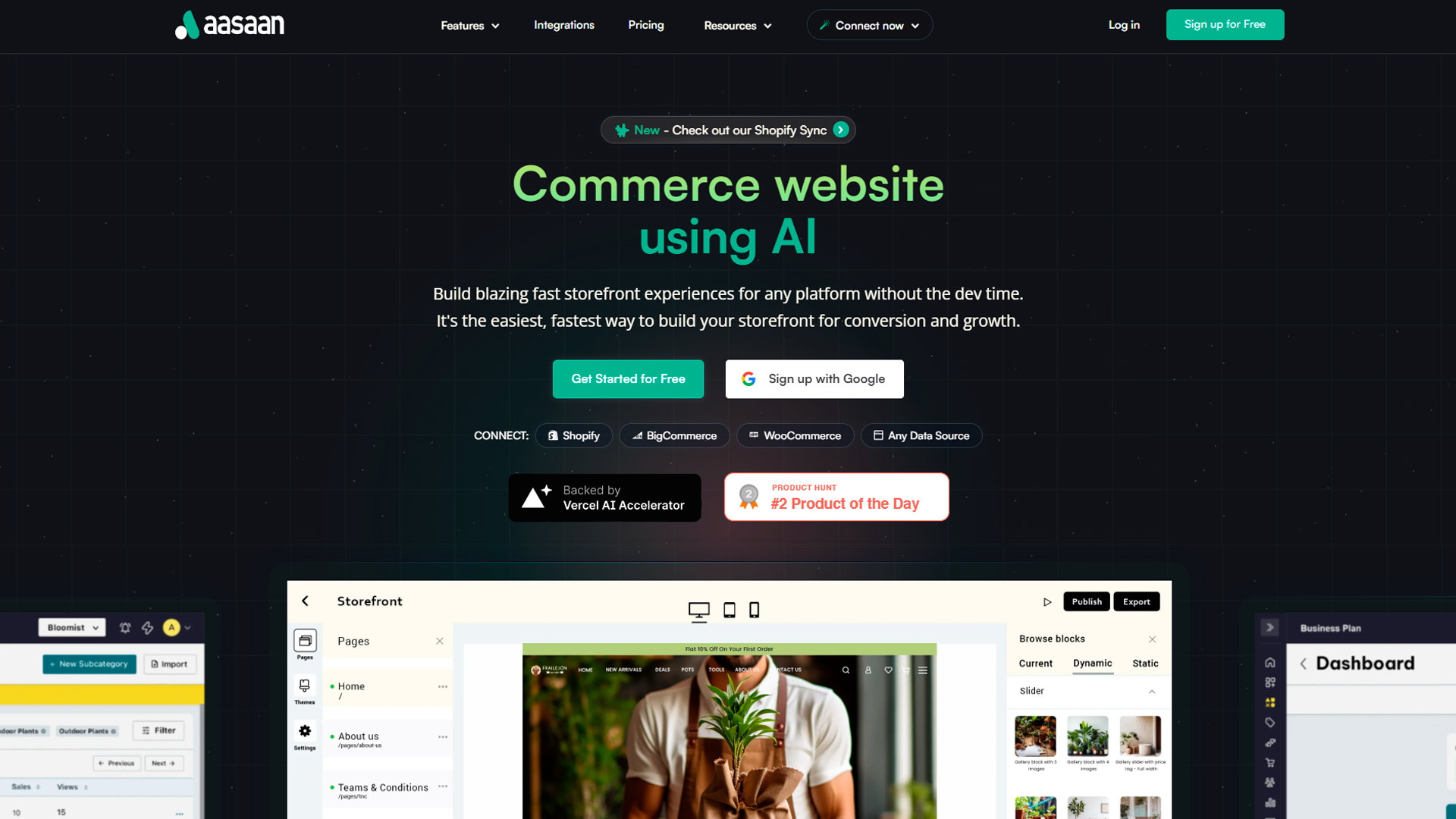
If your business meets multiple criteria mentioned above, regardless of whether you are an experienced company with a well-established infrastructure or in the process of developing your enterprise architecture, adopting a headless commerce approach could be the right choice for you.
Similarly, if your business operations are growing more intricate and you aim to stand out by offering a superior customer experience rather than merely competing on price, a headless future might be the direction to consider.
Conclusion:
In conclusion, the world of eCommerce has evolved drastically in recent years with the emergence of headless commerce.
This new approach to eCommerce offers greater flexibility and scalability compared to traditional eCommerce, and allows businesses to customize their online shopping experience to better suit their unique needs.
However, it’s important to note that headless commerce may not be the best fit for every business. While it offers a range of benefits, it requires a more technically skilled team and may be more expensive to implement and maintain.
On the other hand, traditional eCommerce platforms provide a more straightforward solution that can be easier to implement and manage for businesses with limited resources.
These platforms come with pre-built templates and plugins that make it easy to set up an online store quickly and easily.
So, which one is better for your business? The answer ultimately depends on your unique needs, budget, and technical expertise. Before making a decision, it’s important to carefully consider the pros and cons of each approach and consult with experts in the field.
Which eCommerce approach do you think is better suited for your business - headless commerce or traditional eCommerce? Let us know in the comments!
FAQ’s:
1. Is Headless Commerce more difficult to set up than Traditional eCommerce?
Yes, Headless Commerce requires more technical expertise and may take longer to set up than Traditional eCommerce.
2. Which option is better for small businesses?
Traditional eCommerce platforms are a great option for small businesses that don’t require a high level of customizability or scalability.
3. Can Headless Commerce be more expensive than Traditional eCommerce?
Yes, Headless Commerce may be more expensive than Traditional eCommerce, as it requires more technical expertise and custom development.
4. Is it possible to switch from Traditional eCommerce to Headless Commerce?
Yes, it’s possible to switch from Traditional eCommerce to Headless Commerce, but it may require more time and resources to make the transition.








